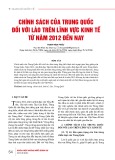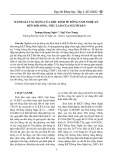
http://www.iaeme.com/IJM/index.asp 88 editor@iaeme.com
International Journal of Management (IJM)
Volume 8, Issue 4, July–August 2017, pp.88–97, Article ID: IJM_08_04_012
Available online at
http://www.iaeme.com/ijm/issues.asp?JType=IJM&VType=8&IType=4
Journal Impact Factor (2016): 8.1920 (Calculated by GISI) www.jifactor.com
ISSN Print: 0976-6502 and ISSN Online: 0976-6510
© IAEME Publication
MAPPING THE CHANGES IN COMPANIES IN
THE REPUBLIC OF MACEDONIA, ACCORDING
TO THE SIZE OF THE COMPANY
Dr. Gjorgji Mancheski
Dean, Faculty of Economics, Prilep, University “St .Kliment Ohridski”, Bitola
Gligorovski Violeta
Phd Student, Department Management, Faculty of Economics,
Prilep, University “St .Kliment Ohridski”, Bitola
ABSTRACT
Changes are essential and competitive concept that helps us understand the
complexity in which companies operate and are part of the complete progress of the
country's economy. The purpose of this research paper, first, is to explicate the types
of changes that are commonly implemented in companies, and second, to map the
changes in the companies in terms of their size, i.e. to map the type of changes
commonly implemented in companies, which factors most commonly influence
companies, which approach of implementation is used by companies and which of the
world practices for competitiveness are commonly implemented in companies.
Methodology. Research was conducted over a period of two months, online, through a
questionnaire composed of 16 questions relating to the issues in this paper. It was
conducted all over the territory of the Republic of Macedonia. The survey included a
variety of industries that companies work in and companies of different sizes. In this
research paper the analyses and findings are presented based on the results of the
research that was conducted. For this purpose descriptive statistics was used and also
exponential statistics, test hypotheses through chi-square test.
Key words: Change management, changes, mapping, implementation.
Cite this Article: Dr. Gjorgji Mancheski and Gligorovski Violeta, Mapping the
Changes in Companies in the Republic of Macedonia, According to the Size of the
Company. International Journal of Management, 8 (4), 2017, pp. 88–97.
http://www.iaeme.com/IJM/issues.asp?JType=IJM&VType=8&IType=4
1. INTRODUCTION
Change management is a discipline whose aim is: to implement changes straightforward in
order to achieve permanent benefit for the company and to have impact on the overall
company and the employees. [1] Depending on the type of changes that will be implemented
in the company, the strategy for managing changes will be determined. Change management

Mapping the Changes in Companies in the Republic of Macedonia, According to the Size of the
Company
http://www.iaeme.com/IJM/index.asp 89 editor@iaeme.com
allows employees to adapt to the changes in order to achieve the business objectives. In fact,
it is a bridge between decisions and results, and fundamental concerns of employees and their
collective role in transforming changes in successful outcomes for the company. [2]
2. TYPES OF CHANGE
Changes can be defined according to the types of criteria that are taken into account for
further diversity. There are many criteria, according to which changes can be divided, but in
this context only a few of them will be mentioned, such as: driving forces, changes coverage,
introducing systematic changes or complete redesign, the rate of change, coverage and depth
of changes, the preliminary preparation for change and so on. Internal and external changes
According to the first criterion, the driving forces, the changes in a company can be internal
and external. Internal factors that cause changes are the following: changes in organizational
strategy. The Company's strategy relates to its overall activity, strategic decisions are
affecting the company in terms of what business it will be dealing with, which are its clients,
how they will be served, and how the company will work internally. - changes in the
workforce. Factors relating to changes in the workforce: increasing the use of teamwork in the
companies, increasing the pressure of communication between employees and the exchange
of information, use of distributed working groups (especially globally), continued
reorganization and restructure in the company, reducing costs, improving the quality of
working life and attracting new employees.[3] - new equipment. Installing new equipment in
the companies involves changes to existing business processes that affect the overall
operation of the company. Changing equipment requires training of employees in the form of
trainings and seminars to introduce the characteristics of the changes to come, and that means
educating everyone involved - the views of employees. The views of employees can be
directed to a person or object. There are three components that form the position of each
employee, including: cognitive component, caused by evaluation of the thing; affective
component caused by a particular emotion; and behavior component, the performance of the
employee. On the other hand, the external factors that cause changes in companies,
predominantly are: - The market. Market trends are manifested by changes in the number of
competition, changes in the competitiveness intensity level and changes in the growth rate of
the market - government laws and regulations. Shifting government laws and regulations
often means transforming the company's operations, particularly in segments concerning
alterations. Sometimes small changes can be made, but the legislation may radically change
the company's strategy - technology. Changes in technology associated with the need for
implementation of a new technological solution in the business process that will contribute to
business growth and Company Development. These changes require special training or proper
education of the staff or hiring new staff that has experience and already know the specific
technology - the labor market. Factors that may operate on the labor market and cause certain
changes associated with demographic trends, technological developments, globalization,
etc;[4] -economic changes. These changes relate to the macroeconomic situation in the
country, and relating to: changes in gross domestic product, economic growth, investment,
monetary policy, fiscal policy, inflation and so on. Individual and organizational changes
According to the criteria of coverage changes, they can be allotted into changes at the
individual or organizational level. Depending on whether the changes are minor and relate
only to a particular segment of the company, they are then called changes at the individual
level, and it also includes processes for implementing new changes by managers. Namely, in
that case, they first make changes at the individual level, where the manager prepares to
transfer the changes to other employees. When the individual has the motivation to do
something different, then other people or even the whole world can begin to change.[5] But
organizational change is much more complex since it involves all employees. Gareth

Dr. Gjorgji Mancheski and Gligorovski Violeta
http://www.iaeme.com/IJM/index.asp 90 editor@iaeme.com
Morgan's (1986) describes the organizational change as a metaphor of machines, organisms,
brains, culture, political system, a prisoner, and instruments of domination, fluctuation and
transformation.[6] In this context will be mentioned only four of the preceding metaphors,
often used by managers, consultants, authors, and in order to explain the organizational
changes, including:
1. The organization as a machine or rational company designed and structured to achieve
predetermined results. 2. The organization as a political system. 3. The organization as a body,
especially when it is seen as an open system that interacts with the environment in which it
operates. 4. The organization as fluctuation and transformation. In this case it refers to an
organization which is in chaos; complexity and paradox, so there is no own determined
system or no control over the changes that are taking place.
Theorist Richard Beckhard, however, developed formulation factors acting on organizational
change, it is:
V x FS x D> R where the relation means
(V-vision, FS- First Steps, D- dissatisfaction, R-resistant to a change.
Or, rather, the vision multiplied by the first steps necessary for change, and multiplied by
vexation with the status quo, should be greater than the resistance to change.[7] Companies
usually focus on two elements of the equation and ignore the third, but if one element is zero,
then the left side of the equation will be zero, which means resistance to change is inevitable.
Radical and incremental change The changes, according to the criteria of whether they are
making systematic or sudden changes, are mainly divided into incremental and radical.
Incremental changes are characterized by continuous progress, affecting some segments of the
company, and usually occur laggardly through the current structure and management
processes. Radical changes, however, relate to the process of establishing a new paradigm in
the company, and transformation of the entire company, creating a new structure and
management, implementation of a completely new technology, introducing new products and
/ or services, the entry of the company and its positioning into a brand new market etc.
Managing incremental changes that are implemented in the company is much easier than
when it comes to management of the radical changes in the company. Fast and slow
change Regarding the urgency of change, or whether a change that should be implemented is
of great urgency, or it can be postponed, changes are divided into fast and slow. Changes are
swift when the agreed timeframe is preserved, especially if suddenly a new technology is
implemented, when is more difficult to adapt to certain changes. [8] Slow changes are slow
and systematic implementation of some change. Planned and unplanned changes
According to the coverage and depth of the changes that are implemented in different
companies, the changes are divided into planned and unplanned. Planned changes are those
for which the management of the company has made deliberate decisions and it guarantees
that they will be implemented. Unplanned changes, however, are those forced from the
outside or external to the company, relating to changes in the demographic composition of the
staff, when differences (gap) occur in employee performance, changes in government laws
and regulations, and economic competence of the global market.[9] To respond to these
changes imposed by the company requires tremendous flexibility and adaptability.
Strategic and partial changes Strategic changes are associated with the company's
mission, and that means changing company’s policy, targeting a new market or change in the
organizational structure. Strategic changes are large, multidisciplinary and complex because
they change the context of the company. Unlike them, partial changes relate only to a

Mapping the Changes in Companies in the Republic of Macedonia, According to the Size of the
Company
http://www.iaeme.com/IJM/index.asp 91 editor@iaeme.com
particular segment of the company and are easier to implement. One or more employees are
usually involved in these changes.
3. ANALYSES
Objective is to prepare a map of the changes regarding the size of the company, but first a
hypotheses testing will be conducted (using the chi-square test to determine the level of
correlation of measured indicators taken as independent variables and the number of
employees), to perceive is there any statistical significances between them. In this context we
made some tests between the number of employees and other variables (the type of changes
that are implemented, the factors that cause the change, ways of implementation in terms of
volume, etc.) in order to establish relations between them.
B1: types of changes that are implemented in the companies
H0 - there is no connection between the number of employees and changes that are
implemented in companies,
H1 – there is a connection between the number of employees and changes that are
implemented in companies. We are testing the hypothesis.
Table 1
Chi-Square Tests
Value
df
Asymp. Sig. (2-sided)
Pearson Chi-Square
14.735a
12
.256
Likelihood Ratio
16.728
12
.160
Linear-by-Linear
Association
.616
1
.433
N of Valid Cases
61
a. 15 cells (75.0%) have expected count less than 5. The minimum expected count is .34.
The table of this testing shows intersection, in this case: between the number of
employees and the type of changes that are often implemented in companies in R .Macedonia,
with 5 features (changes in the company's strategy, changing the old with a new equipment,
implementation of new technology, new market entry, government laws and regulations). The
intersection will give the answer to whether there is any statistical significance between the
number of employees in the company under analysis and the changes it implemented. From
The table the following results can be seen: the theoretical value of the test is X = 14.735
Degree of freedom is df = 12, a P = 0.256, so if you know that α = 0.05, and because the
value of r> α, then it is clear that we need to accept the null hypothesis, and to conclude that
among the researched variables there is no statistical significance, so the type of changes that
are implemented are independent of the number of employees in the company.
B2: factors that cause changes in the company
H0 - there is no connection between the number of employees and the factors that cause
changes in companies
H1 – there is a connection between the number of employees and the factors that cause
changes in companies We are testing hypotheses.

Dr. Gjorgji Mancheski and Gligorovski Violeta
http://www.iaeme.com/IJM/index.asp 92 editor@iaeme.com
Table 2
Chi-Square Tests
Value
df
Asymp. Sig. (2-sided)
Pearson Chi-Square
.187a
3
.980
Likelihood Ratio
.188
3
.980
Linear-by-Linear
Association
.020
1
.888
N of Valid Cases
61
a. 3 cells (37.5%) have expected count less than 5. The minimum expected count is 1.72.
According to the testing these hypotheses show intersection, in this case between: the
number of employees and which factors cause changes (internal or external) in companies in
Macedonia. The crossing is done, and in fact, offers an answer, whether there is any statistical
significance between the number of employees in the company researched and the factors that
cause changes. The table shows the following results: the theoretical value of the test
is X =187 degree of freedom is df = 3, a P = 0.980, knowing that α = 0.05, and because the
value of r> α, then it appears that we have to accept the null hypothesis, and conclude that
among the researched variables there is no statistical significance, or, the number of
employees in the company is independent of the factors that cause change.
B3: the way of adaptation to change in the companies.
H0 - there is no connection between the number of employees and the way of adapting to
changes in companies
H1 – there is a connection between the number of employees and the way of adapting to
changes in companies.
Table 3
Chi-Square Tests
Value
df
Asymp. Sig. (2-sided)
Pearson Chi-Square
8.354a
9
.499
Likelihood Ratio
9.686
9
.376
Linear-by-Linear Association
.655
1
.418
N of Valid Cases
61
a. 12 cells (75.0%) have expected count less than 5. The minimum expected count is .57.
This table, according to the testing, shows between which variables the intersection has
been made, in this case between: the number of employees and the method of implementation
of the changes (radical, slow, fast or incremental) in companies in Macedonia. The crossing
that is made, in fact, provides an answer to whether there is any statistical significance
between the number of employees in the company under research and the method of
implementation of the changes. The table shows the following results: the theoretical value of
the test is X = 8.354 Degree of freedom is df = 9, a P = 0.499, knowing that α = 0.05, and
because the value of r> α, then it is clear that we need to accept the null hypothesis, or to
conclude that among the researched variables there is no statistical significance, or the
number of employees in the company is independent of the factors that cause changes.
B4: implementation of competing international practices for adaptation to
changes
H0 - there is no connection between the number of employees and implementation of
competing international practices for adaptation to environment











![20 câu hỏi Quản lý dự án phần mềm có đáp án [mới nhất]](https://cdn.tailieu.vn/images/document/thumbnail/2025/20251003/hieu2004haha@gmail.com/135x160/78791759734259.jpg)


![Tài liệu Quản lý dự án: Kiến thức nền tảng toàn diện [chuẩn SEO]](https://cdn.tailieu.vn/images/document/thumbnail/2025/20250910/kimphuong1001/135x160/92631757496585.jpg)











